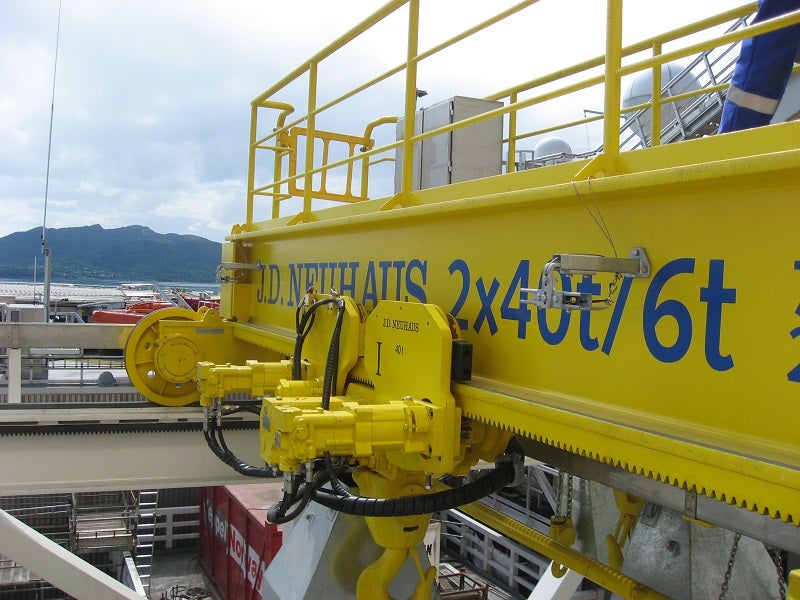
The crane systems manufactured by material handling specialists J D Neuhaus are designed for arduous operating conditions, and have a proven track record throughout worldwide installations.
Industry applications include oil and gas exploration and processing locations, both on and offshore, where explosion-proof operating conditions are paramount. Utilising an impressive range of compliance standards ensures that the JDN equipment is also suitable for safe operation in a wide range of industrial and commercial activities, meeting the relevant safety standards where appropriate. Examples include APi 7K, Ansi B30.16, ABs, DNV Approval Programs, NORSOK, tensile strength 2.5, dynamic factor 1.33; safety factor 5:1 acc. to ANSI B30.16.
These JDN handling products are fully supported by a worldwide servicing operation providing product supply, installation, maintenance and service/repair services with traceability through the JDN unique parts marking system.
Typical standard crane systems currently available include: overhead cranes with single or double girder design; underhung cranes, including low headroom design, jib cranes, cranes with in-line mechanically linked synchronised hoists, cranes with parallel operating hoists, crane capacities up to 100t, crane operation spans up to 36m. All products are suitable for both indoor and outdoor installations with optional power supplies for compressed air or hydraulics.
The J D Neuhaus cranes and hoists are resistant to dust, humidity and aggressive atmospheres as standard, operating within a temperature range of -20°C to 70°C. They provide 100% duty ratings with no downtime and only minimal maintenance requirements. Overload protection and fail-safe braking are incorporated with emergency-stop safety features. Special limit switch arrangements for end-travel, anti-collision and protected zone status can also be incorporated as required.
Both standard and custom-built crane designs can be supplied with crane kits, to fully accommodate customers’ design and build requirements. Component kits complete with pneumatic or hydraulic drives can be supplied to crane manufacturers for overhead travelling cranes up to ten tonnes capacity. The customer simply provides the main girder with JDN supplying all the necessary components for building a crane to their chosen design. Along with hoist and trolleys, JDN provide end carriages with drives, energy feed systems and appropriate safety accessories.
JDN crane systems have been utilised in many general engineering operations ranging from typical heavy-duty operations such as power plants, refineries, sawmills, foundries, shipyards to even explosives and pyrotechnics manufacture. The Ex classifications applicable to the JDN products according to EC Directive on Hazardous Locations 2014/34/EU are EX II 2 GD IIA T4 / II 3 GD IIB T4. A higher rating available featuring increased spark protection is EX II 2 GD IIC T4.
Other industries that have less demanding load requirements, but still require explosion protection include chemical and cement plants, sawmills, paint shops, oil storage plants, electro-plating and some aspects of food production where there is potential for dust-laden (and potentially explosive) environments being created.
For general engineering requirements, super-silent operation is available in the hydraulic powered range, while oil or HFC pressure fluids can be used at intake pressures of 100bar to 180bar. Only two supply connections are required per hoist with leakage oil drained internally for maximum safety and cleanliness of the working environment.
The JDN range of compressed air operated hoists, operating at 4bar or 6bar pressure, incorporate integrated overload switch-off functions. They also feature sensitive, infinite controls with controlled load-lowering in the event of power failures.
J D Neuhaus also specialise in the provision of crane systems adapted to suit individual customer requirements. This can include remote radio control of the crane lift and traverse operations, covering comprehensive application requirements and even simultaneous operation of multiple hoists. For lifting operations on offshore rigs or seagoing vessels, crane systems can be fitted with rack and pinion drive systems to ensure safe operation during bad-weather conditions. Control boxes with receiver can also be customised to suit specific electro-hydraulic interface requirements, together with all necessary system tubing in stainless steel where required.
Recently introduced nickel-plated hoist units have been introduced for operations where wash-down cleaning is utilised, such as food and pharmaceuticals manufacture, or wherever other clean-room operating is needed.

